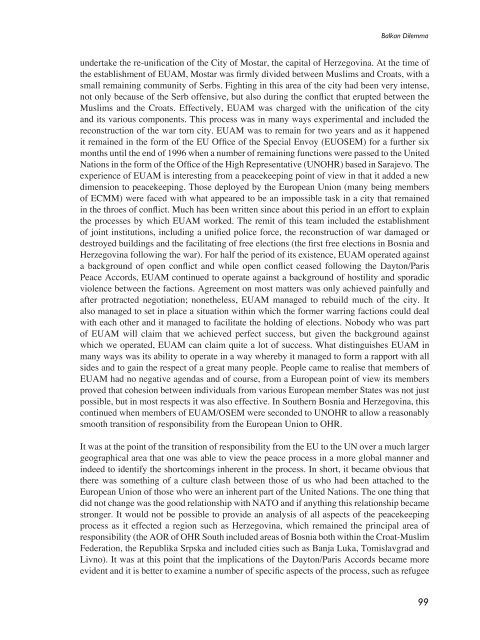Defence Forces Review 2008
Defence Forces Review 2008
Defence Forces Review 2008
Create successful ePaper yourself
Turn your PDF publications into a flip-book with our unique Google optimized e-Paper software.
Balkan Dilemma<br />
undertake the re-unification of the City of Mostar, the capital of Herzegovina. At the time of<br />
the establishment of EUAM, Mostar was firmly divided between Muslims and Croats, with a<br />
small remaining community of Serbs. Fighting in this area of the city had been very intense,<br />
not only because of the Serb offensive, but also during the conflict that erupted between the<br />
Muslims and the Croats. Effectively, EUAM was charged with the unification of the city<br />
and its various components. This process was in many ways experimental and included the<br />
reconstruction of the war torn city. EUAM was to remain for two years and as it happened<br />
it remained in the form of the EU Office of the Special Envoy (EUOSEM) for a further six<br />
months until the end of 1996 when a number of remaining functions were passed to the United<br />
Nations in the form of the Office of the High Representative (UNOHR) based in Sarajevo. The<br />
experience of EUAM is interesting from a peacekeeping point of view in that it added a new<br />
dimension to peacekeeping. Those deployed by the European Union (many being members<br />
of ECMM) were faced with what appeared to be an impossible task in a city that remained<br />
in the throes of conflict. Much has been written since about this period in an effort to explain<br />
the processes by which EUAM worked. The remit of this team included the establishment<br />
of joint institutions, including a unified police force, the reconstruction of war damaged or<br />
destroyed buildings and the facilitating of free elections (the first free elections in Bosnia and<br />
Herzegovina following the war). For half the period of its existence, EUAM operated against<br />
a background of open conflict and while open conflict ceased following the Dayton/Paris<br />
Peace Accords, EUAM continued to operate against a background of hostility and sporadic<br />
violence between the factions. Agreement on most matters was only achieved painfully and<br />
after protracted negotiation; nonetheless, EUAM managed to rebuild much of the city. It<br />
also managed to set in place a situation within which the former warring factions could deal<br />
with each other and it managed to facilitate the holding of elections. Nobody who was part<br />
of EUAM will claim that we achieved perfect success, but given the background against<br />
which we operated, EUAM can claim quite a lot of success. What distinguishes EUAM in<br />
many ways was its ability to operate in a way whereby it managed to form a rapport with all<br />
sides and to gain the respect of a great many people. People came to realise that members of<br />
EUAM had no negative agendas and of course, from a European point of view its members<br />
proved that cohesion between individuals from various European member States was not just<br />
possible, but in most respects it was also effective. In Southern Bosnia and Herzegovina, this<br />
continued when members of EUAM/OSEM were seconded to UNOHR to allow a reasonably<br />
smooth transition of responsibility from the European Union to OHR.<br />
It was at the point of the transition of responsibility from the EU to the UN over a much larger<br />
geographical area that one was able to view the peace process in a more global manner and<br />
indeed to identify the shortcomings inherent in the process. In short, it became obvious that<br />
there was something of a culture clash between those of us who had been attached to the<br />
European Union of those who were an inherent part of the United Nations. The one thing that<br />
did not change was the good relationship with NATO and if anything this relationship became<br />
stronger. It would not be possible to provide an analysis of all aspects of the peacekeeping<br />
process as it effected a region such as Herzegovina, which remained the principal area of<br />
responsibility (the AOR of OHR South included areas of Bosnia both within the Croat-Muslim<br />
Federation, the Republika Srpska and included cities such as Banja Luka, Tomislavgrad and<br />
Livno). It was at this point that the implications of the Dayton/Paris Accords became more<br />
evident and it is better to examine a number of specific aspects of the process, such as refugee<br />
99
















